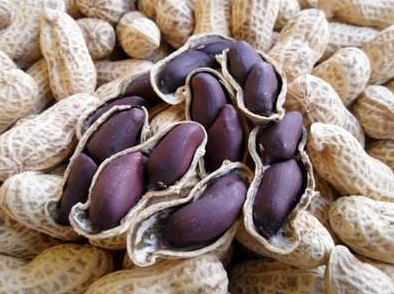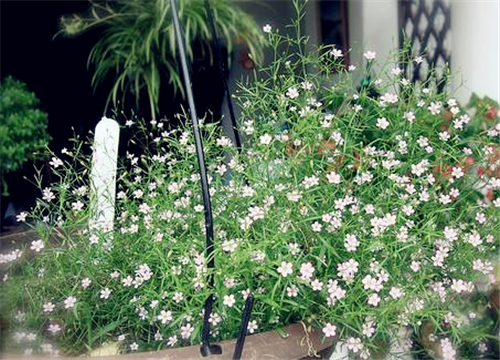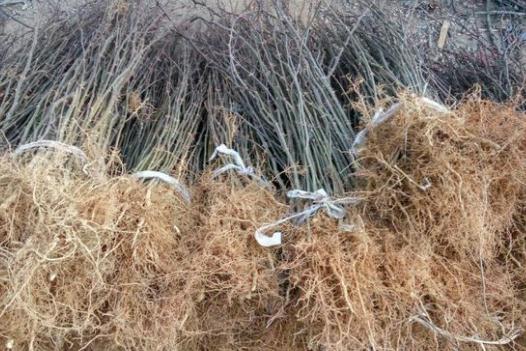How to grow purple peanuts with high yield? High-yielding scientific planting techniques of purple peanut
Purple peanut is black peanut, which is a new type of peanut with high nutritional value and has a very good planting prospect. So how to grow purple peanuts to produce high yield? What are the high-yield scientific planting techniques of purple peanut?

I. soil selection and treatment
Purple peanut is suitable for all kinds of soil with pH 5.5-7.2, but it is best planted in the soil with deep soil layer, flexible plough layer and good flat drainage. It is the most suitable to cultivate sandy loam with loose layer and deep living layer.
The plots for planting purple peanuts should be deeply ploughed with 25~30cm, and 2500~3000kg manure should be applied per mu combined with winter ploughing. The following year, the Spring Equinox began shallow ploughing of 10~13cm. It is necessary to rake along with the ploughing and preserve the soil moisture. When the soil temperature at the depth of 5cm is more than 15 ℃, the seeds can be sown. Seed dressing should be carried out before sowing: 50% phoxim 100g mixed with 50kg seeds can control underground pests; 40%-50% carbendazim 150g 250g seed dressing 50kg can control stem rot and seedling blight. Combined with soil preparation, fermented high quality organic fertilizer 2000kg, diammonium phosphate 20~25kg, urea 10kg, potassium chloride 12.5~15kg, boron fertilizer 0.5kg and zinc fertilizer 1.0kg were applied per mu.
2. Cultivation methods and seed treatment
1. Ridging planting
Row spacing 30~40cm, ridge width 55~60cm, ridge height 10~15cm, double-row planting, row spacing 25cm, hole spacing 15cm, sowing depth 5cm, sowing density 8500-10000 holes / mu, 2 seeds per hole. Ridging planting can deepen the living soil layer, make it exposed to light on three sides, increase the ground temperature, and is beneficial to drainage and irrigation, fruit needle penetration and pod growth and development.
two。 Plastic film mulching
Sowing in the first and middle of April in our township, it is appropriate for the ridge to be high 10~12cm, but it is not easy to keep the ridge surface wide. When mulching, the soil pressure on the lower edge of the ridge slope is not strict and not solid, and the plastic film is easy to be blown up by the wind; too low is not conducive to drainage.
3. Seed treatment
It is required to select the double-grain fruit, dry it with shell for 2 days before shelling, and select the first-class healthy rice to be planted after shelling. It is suggested that seed dressing with rare earth or seed coating agent and application of 2g borax plus 2g rare earth to 1kg seeds can significantly improve the yield and quality of peanut.
Third, how can purple peanuts be planted with high yield?
1. Control of diseases, pests and weeds
After sowing purple peanuts, the herbicides were sprayed in time when the soil was wet, and the soil was closed for weeding. Generally choose 50% of dimethamine, Acetochlor and other agents. Spraying agents should be uniform and comprehensive. Purple peanut has strong resistance and less diseases and insect pests. Attention should be paid to the occurrence of insect pests such as aphids, cotton bollworms and red spiders. Prevention should be given priority to for diseases. Fungicides such as carbendazim and mancozeb were sprayed once or twice a month to prevent common diseases such as peanut leaf spot, black spot, powdery mildew, stem rot and so on. If the disease occurs, 20% trimethoprim 1500 × 2000 times, 70% methyl topiramate 1200 times, 65% mancozeb 600x and agricultural resistance 12020000300 times can be used to control the disease at the initial stage of the disease, with an interval of 10 to 15 days.
two。 Fine management
(1) replanting in time
During the sowing period, seed buds die and seedlings break due to poor seed quality, insufficient soil moisture, improper soil preparation and fertilization, harm of diseases and insect pests and bad climate of low temperature. Therefore, after sowing for 10 to 15 days, peanut sprouting and replanting should be accelerated in time to ensure the whole seedling.
(2) punching and breaking the membrane.
After the emergence of peanut seedlings covered with plastic film, the seedlings should be perforated and broken in time, and after the first true leaf emerges and turns green, the film should be broken before 10:00 in the morning and after 14:00 in the afternoon, 5cm should be drilled, and the leaves should be gently peeled off by hand. Then seal the soil gently and compact the plastic film, otherwise it is easy to burn the seedlings.
(3) watering in case of drought
If you encounter drought in the flower-needle stage, pod-bearing stage and pod expansion period, you must resist drought and water in time. Drought-resistant watering is best to use sprinkler irrigation, and appropriate extension of sprinkler irrigation time, spray water appropriate increase, so that there is an appropriate amount of water storage in the ditch, in order to moisture from the ditch to the ridge, but strictly prevent the flood over the ridge. After watering, ploughing the furrow once when it is suitable for dry and wet, to prevent soil consolidation and weeds in the ditch, and to ensure that the fruit needle enters the soil in time and the pods expand and bear fruit. But in case of waterlogging, timely drainage, strictly prevent rotten fruit.
3. Extra-root fertilization
The main results are as follows: (1) the effect of extra-root fertilization on purple peanut foliar fertilization has the characteristics of high fertilizer absorption and utilization, saving fertilizer and increasing yield. With foliar application of nitrogen fertilizer, the absorption and utilization rate of peanut plants reached more than 55.5%, the number of full fruits increased significantly, and the economic coefficient increased significantly; foliar application of phosphate fertilizer can generally increase the yield by 7% to 10%; foliar application of micro-fertilizers such as aluminum, boron, manganese and iron can generally increase the yield by 8% and 10%. A large number of elements such as nitrogen, phosphorus, potassium, calcium and trace elements such as molybdenum, boron, manganese and iron can be applied to leaves.
(2) fertilization methods:
① nitrogen fertilizer: the urea 0.5kg is called and the urea aqueous solution dissolved into 1% is fully stirred with clear water 50kg. Purple peanut can be sprayed if there is a phenomenon of de-fertilization in the middle and later stage of growth, or continuous rainfall during the growing period, soil waterlogging, and difficulties in absorbing nutrients by roots.
② phosphate fertilizer: purple peanut has a strong ability to absorb phosphorus. Spraying 2%-3% calcium superphosphate aqueous solution in the middle and later stages of growth can increase the rate of photosynthate transporting to pods and increase pod yield. The specific method is to put 1~1.5kg superphosphate in 50kg water, stir and soak, after 1 day and night, take its upper clarification solution to apply, generally every 7 to 10 days to spray, spray 2 times 3 times, each time spray 600kg per mu. Care should be taken to remove the residue thoroughly so as not to damage the leaves.
Mixed application of ③ nitrogen and phosphorus: in peanut fields lacking phosphorus and nitrogen, 1% urea and 2% calcium superphosphate mixture can be sprayed, which is labor-saving and effective. The preparation method of the mixture is to add urea 0.5kg to the 50 kg 2% calcium superphosphate aqueous solution.
④ potash fertilizer: generally prepared with plant ash. The preparation method is to take the plant ash 2.5~5kg that is not drenched in the rain, add water 50kg to stir fully, soak for 12 hours for 14 hours, and take the clarification solution, that is, 5%-10% plant ash leaching solution, spraying 60kg per mu each time. Potassium sulfate or potassium chloride aqueous solution can also be used, and the preparation method is to add potassium sulfate or potassium chloride 1kg to 50kg clear water, stir and dissolve to form 2% potassium sulfate or potassium chloride aqueous solution, and 60kg is sprayed every mu.
Combination of ⑤ phosphorus and potassium: take dry plant ash 2.5kg, soak with water 20~25kg, at the same time take calcium superphosphate 1kg, sprinkle it into the soaking solution, fully stir well, filter out the clear solution half a day later, add water 10kg, soak and filter, and then combine the filtrate twice to 50kg, that is, the potassium dihydrogen phosphate produced by native method is sprayed with 60kg per mu, spraying twice can obviously increase production.
4. Control growth
In the plastic film purple peanut needle to pod stage, with the arrival of high temperature and humidity, it is easy to cause prosperous growth. In order to control the vigorous growth of peanut, about 20g of Zhuangfeng amine per mu should be sprayed on the leaf of water 40kg twice from the late stage of needling to the early stage of podding. Zhuangfeng amine can dwarf plant height, promote leaf photosynthesis, improve the distribution of photosynthates, increase fruit weight, and steadily increase yield by more than 10%.
5. Increase application of foliar fertilizer
Purple peanut needs a large amount of fertilizer in the middle and later stage, so the application of foliar fertilizer should be strengthened from flowering stage. It should be sprayed once every 7-10 days and 3 times continuously. Commonly used foliar fertilizers are: 2% superphosphate leaching solution, 0.3% potassium dihydrogen phosphate solution, 0.1% 0.2% calcium molybdate, 1% 2% urea, especially 30% 40 days before harvest, adding 1% urea + 0.3% potassium dihydrogen phosphate to prevent premature senescence, promote nutrient accumulation, increase yield, and improve pod quality.
6. Suitable harvest time
Purple peanut has high water content, slow dehydration and short post-ripening period during pod ripening, so it should be harvested in an appropriate time to prevent budding and rotten fruit. When the leaves of the middle and lower parts of the plant fall off normally, the leaves of the upper fruit branches of the plant turn yellow, the network of fruit shells is clear, and the seeds are black and shiny. If the harvest is too early, the pod is not full, resulting in a reduction in yield; if the harvest is too late, the pod is easy to fall off. The growth period of purple peanut is about 125 days.
The above is about purple peanut high-yield scientific planting technology, purple peanut market price is high, but also a new variety, there are very good planting prospects, if you want to develop the planting industry might as well try to grow purple peanuts.
Time: 2019-03-14 Click:
- Prev

How to raise the full stars bought? Do you want to put it in water or dry stocking? Note that these two points are growing more and more prosperous!
The full sky star is bound to be a common flower, and its flower language represents purity, care, true love and a beautiful heart. Therefore, many friends began to raise the stars directly, so how to raise the stars? Do you want to put it in water or dry stocking? The details are as follows: how can the full stars bought by the florist be raised to improve the survival rate?
- Next

[planting technology] what are the planting methods of Zanthoxylum bungeanum? How much is a sapling?
Zanthoxylum bungeanum is one of the seasonings we usually use, and it has a long history of cultivation in China. It is a widely distributed spice and oil tree species with great economic benefits. What are the planting methods of Zanthoxylum bungeanum tree? How much is a prickly ash sapling? Planting method of Zanthoxylum bungeanum
Related
- Fuxing push coffee new agricultural production and marketing class: lack of small-scale processing plants
- Jujube rice field leisure farm deep ploughing Yilan for five years to create a space for organic food and play
- Nongyu Farm-A trial of organic papaya for brave women with advanced technology
- Four points for attention in the prevention and control of diseases and insect pests of edible fungi
- How to add nutrient solution to Edible Fungi
- Is there any good way to control edible fungus mites?
- Open Inoculation Technology of Edible Fungi
- Is there any clever way to use fertilizer for edible fungus in winter?
- What agents are used to kill the pathogens of edible fungi in the mushroom shed?
- Rapid drying of Edible Fungi

